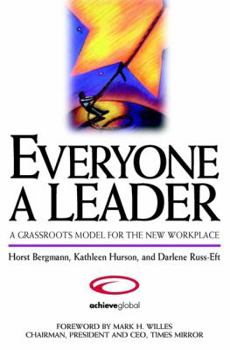Everyone a Leader: A Grassroots Model for the New Workplace
"Finally, a leadership book for today's flat, dynamic, team-based organizations . . . This is the model." -Todd W. Arnold, Vice President, Customer Services, Cinergy Corp. This description may be from another edition of this product.
Format:Hardcover
Language:English
ISBN:0471197637
ISBN13:9780471197638
Release Date:April 1999
Publisher:Wiley
Length:244 Pages
Weight:1.20 lbs.
Dimensions:0.9" x 6.1" x 9.4"
Customer Reviews
2 ratings
A Sound Exposition of the Latest Models of Leadership
Published by Thriftbooks.com User , 23 years ago
This book catches the crest of the post-empowerment, post-New-Leadership wave and is highly recommneded reading for anyone who wants to know about modern management ideas and practices. It has perhaps the best available description of the role of leadership in new, team-based, flat-org-chart work environments.Among its virtues are terseness, practical aids, and reference to empircially based research. While its use of acronym-style models may not appeal to everyone, the authors mercifully do not push this aspect excessively. Page for page, its ideas are sound, clear and made relevant and applicable.The book thus quite lives up to its intention of providing a mental model and practical support for "grassroots leadership". Even so, one can expect further advances in such thought, as well as even more popularization capable of absorption by actually "everyone".
A good mix of research and practical improvement steps
Published by Thriftbooks.com User , 24 years ago
Everyone a Leader explores the value of grassroots leadership. The authors contend that today's workplace presents the opportunity-and the need-for every employee to demonstrate leadership. Their premise: Organizations today cannot survive if leadership is limited to the CEOs, executives and managers.This book offers compelling proof that, equipped with proper tools and support, everyone has the potential to be a leader and make a difference. Everyone a Leader is based on a recent study in which 2,000 managers and non-managers from 450 organizations were asked to recall stories and anecdotes about small, often-overlooked turning points in an organization's daily life. These "critical incidents" illustrate the limitless opportunities for any person in an organization to demonstrate good leadership-or poor leadership.Sixty-eight percent of the incidents described the actions of a manager or supervisor; the rest described non-managers and non-supervisors. The incidents were examined and found to encompass 17 common attributes of leadership. These competencies then were related to five key strategies the authors call the CLIMB model of leader effectiveness:Create a compelling future. Let the customer drive the organization. Involve every mind. Manage work horizontally. Build personal credibility.More than a research report A surprisingly large number of the critical incidents described poor leadership. These seemed to indicate that many formal leaders either don't have the needed skills, or aren't aware of the opportunities to "seize the moment." On the other hand, many incidents of "good leadership behavior" came from what the authors call Grassroots Leaders-people in the frontline or in support positions who emerge during critical moments to act as leaders.Everyone a Leader goes beyond merely reporting the research findings. The book is chock-full of practical how-to's and personal strategies for achieving each of the CLIMB components. Powerful examples from the research underscore each point.Half the critical incidents were related to the Involve Every Mind strategy described in Chapter Four. And half of these incidents were negative-leaders who minimized individual and team effort, withheld information or missed opportunities to share it, and either sidestepped decisions that could have solved problems or arrived at decisions in a way that made things worse. Most disturbingly, the negative behaviors made a strong and even indelible impression on the respondents but were quickly forgotten by the people who performed them. These leaders were unconsciously poisoning the organization they were supposed to maintain and improve.Vivid examples of poor leadership described behaviors ranging from thoughtless to rude and even vulgar. The authors show how easily these situations could be turned around using basic people skills: listen, share information, coach, praise, have patience and be persistent. Stressing the imp





